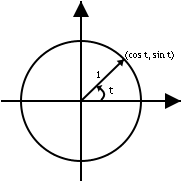Unit circle
|
|
In mathematics, a unit circle is a circle with unit radius, i.e., a circle whose radius is 1. Frequently, especially in trigonometry, "the" unit circle is the circle of radius 1 centered at the origin (0, 0) in the Cartesian coordinate system in the Euclidean plane. The unit circle is often denoted S1.
If (x, y) is a point on the unit circle in the first quadrant, then x and y are the lengths of the legs of a right triangle whose hypotenuse has length 1. Thus, by the Pythagorean theorem, x and y satisfy the equation
- <math>x^2 + y^2 = 1 \,\!<math>
Since x2 = (−x)2 for all x, and since the reflection of any point on the unit circle about the x- or y-axis is also on the unit circle, the above equation holds for all points (x, y) on the unit circle, not just those in the first quadrant.
One may also use other notions of "distance" to define other "unit circles"; see the article on normed vector space for examples.
Trigonometric functions on the unit circle
The trigonometric functions cosine and sine may be defined on the unit circle as follows. If (x, y) is a point of the unit circle, and if the ray from the origin (0, 0) to (x, y) makes an angle t from the positive x-axis, (where the angle is measured in the counter-clockwise direction), then
- <math>\cos(t) = x \,\!<math>
- <math>\sin(t) = y \,\!<math>
The equation x2 + y2 = 1 gives the relation
- <math> \cos^2(t) + \sin^2(t) = 1 \,\!<math>
The unit circle also gives an intuitive way of realizing that sine and cosine are periodic functions, with the identities
- <math>\cos t = \cos(2\pi k+t) \,\!<math>
- <math>\sin t = \sin(2\pi k+t) \,\!<math>
- for any integer k.
These identities come from the fact that the x- and y-coordinates of a point on the unit circle remain the same after the angle t is increased or decreased by any number of revolutions (1 revolution = 2π radians).
When working with right triangles, sine, cosine, and other trigonometric functions only make sense for angle measures more than zero and less than π/2. However, using the unit circle, these functions have sensible, intuitive meanings for any real-valued angle measure.
Circle group
Complex numbers can be identified with points in the Euclidean plane, namely the number a + bi is identified with the point (a, b). Under this identification, the unit circle is a group under multiplication, called the circle group. This group has important applications in math and science; see circle group for more details.
See also
da:Enhedscirklen de:Einheitskreis fr:Cercle trigonométrique ja:単位円 ko:단위원 (기하) nl:Eenheidscirkel sr:Јединични круг

